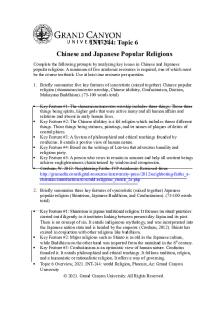Niema Smith Chineseand Japanese Popular Religions PDF

| Title | Niema Smith Chineseand Japanese Popular Religions |
|---|---|
| Author | Niema Smith |
| Course | World Religion |
| Institution | Grand Canyon University |
| Pages | 3 |
| File Size | 133.1 KB |
| File Type | |
| Total Downloads | 46 |
| Total Views | 117 |
Summary
hope this helps...
Description
INT-244: Topic 6 Chinese and Japanese Popular Religions Complete the following prompts by analyzing key issues in Chinese and Japanese popular religions. A minimum of five academic resources is required, one of which must be the course textbook. Use at least one resource per question. 1. Briefly summarize five key features of syncretistic (mixed together) Chinese popular religion (shamanism/ancestor worship, Chinese idolatry, Confucianism, Daoism, Mahayana Buddhism). (75-100 words total)
Key Feature #1: The shamanism/ancestors worship includes three things. Those three things being spirits, higher gods that were active inany and all human affairs and relations and absent in early human lives. Key Feature #2: The Chinese idolatry is a fol religion which includes threee different things. Those things being statuses, paintings, and/or names of plaques of deties of central places. Key Feature #3: A System of philosophical and ethical teachings founded by confucius. It entails a postive view of human nature. Key Feature #4: Based on the writings of Loa-tzu that advocates humility and religious piety. Key Feature #5: A person who vows to remain in samsara and help all sentient beings achieve englightenment; characterized by wisdom and compassion. Corduan, W. 2012. Neighboring Faiths. IVP Academic. Retrieved from: http://gcumedia.com/digital-resources/intervarsity-press/2012/neighboring-faiths_achristian-introduction-to-world-religions_ebook_2e.php
2. Briefly summarize three key features of syncretistic (mixed together) Japanese popular religion (Shintoism, Japanese Buddhism, and Confucianism). (75-100 words total)
Key Feature #1: Shintoism is japans traditional religion. It focuses on ritual practices carried out diligently as it institutes linking between present-day Japan and its past. There is no concept of sin. It entails indigenous mythology, and was incorporated into the Japanese nation state and is headed by the emperor. (Corduan, 2012). Shinto has existed in conjuction with other religious like buddhism. Key Feature #2: Major religions such as Shinto is as old as the Japanese culture, while Buddhism on the other hand was imported from the mainland in the 6th century. Key Feature #3: Confucianism-is an optimistic view of human nature. Confucius founded it. It entails philosophical and ethical teachings. It follows tradition, relgion, and a humanistic or rationalistic religion. It offers a way of governing. Topic 6 Overview, 2021. INT-244: world Religion, Phoenix, Az: Grand Canyon University © 2021. Grand Canyon University. All Rights Reserved.
3. Describe key religious practices (e.g., arranging a marriage, funerals, etc.) that an individual follower of Chinese popular religion might do in their daily life or alternatively in a lifetime. Describe practices from at least three of the five religions. (75-100 words) Taoism also known as daoism is a religious or philosocphical tradition of chinese origin. It has to do with lving in harmony with the gods and goddessess who do notg have faith in an individual god. There is no eternal redemption. Salvation permits them to live in harmony with nature and the universe on earth’s endless cycle of destruction and creation. Their main principle is Doa. They also have manifestations and their main goal is to gain balance in life. If they don’t gain immortality, they evolve and manifest in different forms in accordance with the entity;s general conduct during a state of existence.
Berling, J. (2018). Daoism. Asia Society. Retrieved from: https://asiasociety.org/education/daosim
4. Describe key religious practices (e.g., emperor's birthday, birth of a baby, etc.) that an individual follower of Japanese popular religion might do in their daily life or alternatively in a lifetime. Describe practices from at least three of the five religions. (75-100 words) There were moral principles that were influenced by confucianism. Its concept of purity suggested that humans had a moral sense and were driven to avoid doing wrong. It has been thought by Shinto that humans were pure and good and did not have any concept of sin, or humanity. Confucianism believe that humans are good, and teachable, improvable, and perfectible through personal and communal endeavors. This is mostly seen in selfccultivation and self-creation. Confucian emphases on being moral and uses cultivation of virtue.
Boyd, J. & Williams, R. (n.d.). Shinto Purification Rituals: An Aesthetic Interpretation. Retrieved from: https://jhti.berkeley.edu/shinto/project1.html
5. Describe the interaction that a Christian might have with a follower of Chinese or Japanese syncretistic popular religions in a respectful, constructive manner while maintaining clarity and faithfulness to the core Christian message of creation-fallredemption and restoration through Christ alone. Take into account Chinese or Japanese shamanism, ancestor fear, and fear of the spirit world. (200-250 words)
© 2021. Grand Canyon University. All Rights Reserved.
I believe that Christians interact with the followers of Chinese or Japanese popular religions in a respectful yet constructive manner while also maintaining clarity and faithfulness to make sure they continue to follow their path of Christianity. I feel this way mainly because Japanese sometimes distingguish Christianity as a foreign religion. They only practice their two major religions, which include Shinto and Buddhism. Howevere, there is a common similarity that that is shared with Christians. These common rituals include hearing personal testimonies and studying the word of god. These acts are quite comparable to Christianity due to their faith being established from hearing personal testimonies and taking in the word of God.
© 2021. Grand Canyon University. All Rights Reserved....
Similar Free PDFs

World Religions Midterm Guide
- 8 Pages

Japanese weather
- 4 Pages

World Religions Review
- 8 Pages

Japanese Encephalitis NOVITA
- 12 Pages

Exploring World Religions Summary
- 19 Pages

Democracia Popular
- 2 Pages

KULTURANG POPULAR
- 22 Pages

2.Indigenous Religions
- 28 Pages

Karmiloff Smith
- 7 Pages

John Smith
- 6 Pages

Japanese subject outline
- 12 Pages

Informal Introduction in Japanese
- 37 Pages
Popular Institutions
- Tinajero National High School - Annex
- Politeknik Caltex Riau
- Yokohama City University
- SGT University
- University of Al-Qadisiyah
- Divine Word College of Vigan
- Techniek College Rotterdam
- Universidade de Santiago
- Universiti Teknologi MARA Cawangan Johor Kampus Pasir Gudang
- Poltekkes Kemenkes Yogyakarta
- Baguio City National High School
- Colegio san marcos
- preparatoria uno
- Centro de Bachillerato Tecnológico Industrial y de Servicios No. 107
- Dalian Maritime University
- Quang Trung Secondary School
- Colegio Tecnológico en Informática
- Corporación Regional de Educación Superior
- Grupo CEDVA
- Dar Al Uloom University
- Centro de Estudios Preuniversitarios de la Universidad Nacional de Ingeniería
- 上智大学
- Aakash International School, Nuna Majara
- San Felipe Neri Catholic School
- Kang Chiao International School - New Taipei City
- Misamis Occidental National High School
- Institución Educativa Escuela Normal Juan Ladrilleros
- Kolehiyo ng Pantukan
- Batanes State College
- Instituto Continental
- Sekolah Menengah Kejuruan Kesehatan Kaltara (Tarakan)
- Colegio de La Inmaculada Concepcion - Cebu



